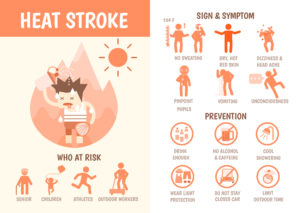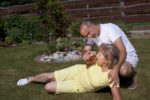 The body is very effective at Thermoregulation – maintaining the correct internal temperature in extreme conditions of heat and cold. As humans, we can go skiing in freezing cold conditions or lay on a hot sunny beach.
The body is very effective at Thermoregulation – maintaining the correct internal temperature in extreme conditions of heat and cold. As humans, we can go skiing in freezing cold conditions or lay on a hot sunny beach.
Controlling the Temperature of the Body
We control our temperature by various means. Some are conscious decisions we make. These are things such as adding or removing clothing, go inside and sit by a heater to keep warm or go for a swim in cool water to cool down. The human body also has an automatic thermostat. This maintains our temperature by adjusting circulation and heartbeat. Our bodies shiver to warm up and sweat to cool down. These are called Negative Feedback Loops, as they return the body to a normal condition. Problems can occur when this thermostat does not function correctly due to extremes in temperature.
Heat Exhaustion
When the body heats up, heat exhaustion starts to occur. With this, the patient becomes very hot, very sweaty and becomes more and more distressed. The patient will start to feel nauseous, and while heat exhaustion is not an absolute emergency, the patients’ condition can deteriorate quickly. Therefore you must treat this situation quickly and seriously. You can control heat exhaustion by moving the patient into a cooler environment and giving them sips of cool water.
Heat Stroke
Heat stroke is a much more serious condition. This is where the body’s thermostat fails due to extreme temperature. Instead of Negative Feedback Loops occuring, the system is starting to break, causing the opposite to occur. The body stops sweating, making it harder to cool the body down. This is called a Positive Feedback Mechanism, as instead of the body returning to a normal condition, it is making the problem worse itself. Heat stroke is an absolute emergency, and the Emergency Medical Services should be called as soon as possible.
With heat stroke, do not give the patient anything to drink. The most obvious sign of heat stroke is that they no longer sweat, meaning they will have dry skin. Treatment includes cooling the person using cold wet towels or a hose until the emergency services arrive. Keep monitoring the patient at all times for his ABCDs. One important factor with any heat-related problem is dehydration. So whenever you are at extreme temperatures, ensure that you drink plenty of water. This will help prevent heat stroke by making sure that your body is hydrated enough to control its own temperature effectively.
For more information on training courses, visit our “Courses” page which also includes our First Responder and First Person on Scene (FPOS) Courses.

